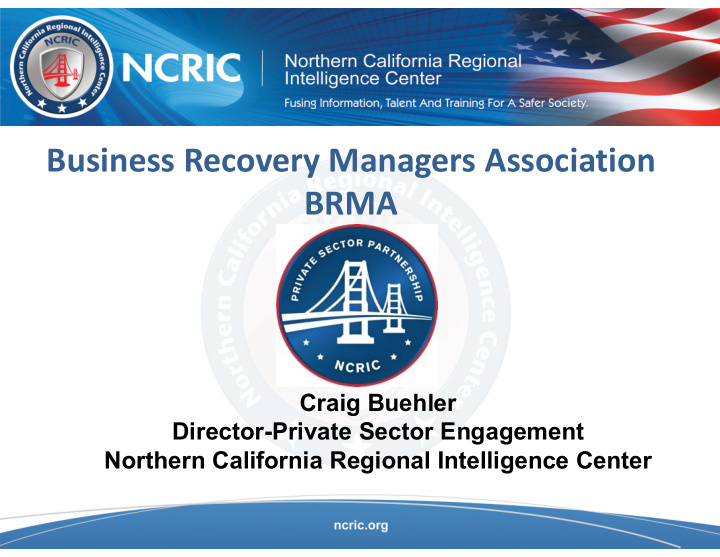



Business Recovery Managers Association BRMA Craig Buehler Director-Private Sector Engagement Northern California Regional Intelligence Center
The 9/11 Commission Markle Foundation Task Force -Why did this happen, where did Government fail? -What does Government have to do differently? 2 U//FOUO
Markle Foundation Task Force Testimony – 9/11 Commission identified, both the CIA and the FBI failed to disseminate information in the run-up to the attacks. “The culture that led to this failure is vividly illustrated by a CIA analyst who told the 9/11 Commission that he did not volunteer information he knew about a suspected terrorist when the FBI showed him surveillance pictures of the individual because he “was not authorized to answer FBI questions regarding CIA information.”
Recommendations - 9/11 Commission and the Markle Foundation Reports National Network of Fusion Centers is Established • Improve Information Sharing • Law Enforcement must work closer together to “connect the dots” • Fusion Centers Established 4 U//FOUO
Government-United States of America – 14- Territories – 3142- Counties or County Equivalent – 19,354- Cities and Towns
Law Enforcement in the United States • Approximately 800,000+ Law Enforcement Officers • Federal- 73- Agencies i.e. FBI, DHS, DEA, TSA CBP/ 17- Separate Intelligence Agencies under Office of the Director of National Intelligence- 120,000 Federal Law Enforcement Officers • State- Each State has numerous Law Enforcement Agencies i.e. State Police/Patrol, Narcotic Enforcement, General Investigations, Fish and Game, Firearms, Gambling, Narcotic Enforcement, Lottery • County- 3000+ Sheriff’s Departments • Municipal- 18,000+ Police Departments • Other Public Safety
Critical Infrastructure Key Resources • 16,000 Cataloged Critical Infrastructure Sites in the NCRIC Area of Responsibility (AOR) Over 85% is Owned and Operated by the Private Sector •
Purpose of a Fusion Center? – Creates a information sharing environment for local, State and Federal LE, Public Safety Officials and our Private Sector Partners – Supplement and Enhance Law Enforcement Antiterrorism/Crime Fighting and Intelligence Efforts – Increased Situational Awareness – Provides Criminal Intelligence access and capabilities for law enforcement agencies that previously didn’t have them – Enhanced effort to collect and evaluate reported Suspicious Activity
Additional NCRIC Services: – Cybersecurity support – Critical Infrastructure Protection – Special Event Planning – Specialized Training – Facilitate interaction with the overall Intelligence Community – Liaison/Outreach Program: Law Enforcement Public Safety/Emergency Services Private Sector Partners
National Network of Fusion Centers ncric.org
The State Threat Assessment System (STAS) Four regional fusion centers established California in late 2004 State Threat Assessment Center (STAC) Sacramento Central California San Francisco Intelligence Center (CCIC) Northern California Regional Intelligence Center (NCRIC) E A S T E R N Los Angeles Joint Regional Intelligence Center (JRIC) C E N T R A L Orange County Intelligence Assessment Center (OCIAC) SOUTHERN San Diego Law Enforcement Coordination Center (SD-LECC) ncric.org
Reporting Suspicious Activity to Fusion Centers • Nationwide Suspicious Activity Reporting Initiative Detect, prevent or deter terrorism and other related criminal activity • Fusion Center Role Intake, Evaluation, Analysis, Dissemination • FBI- Joint Terrorism Task Force Lead Agency-Investigation • Suspicious Behavior and Terrorism Preplanning
Nationwide SAR Initiative: 16 Suspicious Behaviors Defined criminal activity Potential criminal activity* Breach/Attempted Intrusion Eliciting Information Misrepresentation Testing or Probing of Security Theft/Loss/Diversion Recruiting Sabotage/Tampering/ Vandalism Photography Cyber Attack Observation/Surveillance Expressed or Implied Threat Materials Acquisition/Storage Aviation Activity Acquisition of Expertise Weapons Discovery Sector-Specific Incident * Protected activities that require additional facts or circumstances to support their characterization as reasonably indicative of criminal activity associated with terrorism
www.ncric.org Report Suspicious Activity
Communication Tool Mobile SAR Reporting
NCRIC Partner Update Brief One-stop info shopping: Suspicious Activity Officer Safety Regional Crime Alerts and Analysis Training Calendar 16 UNCLASSIFIED//FOR OFFICIAL USE ONLY
New at the NCRIC • Cyber Security Unit- strategic threat intelligence, network security services, cybersecurity training, shares best practices for mitigating cyber threats, free security assessments, vulnerability scans and phishing exercises for end-users • Developing a strategic plan to better collaborate with the California Resiliency Alliance (CRA) during major critical events • Government Private Sector Engagement Working Group NCRIC, FBI, DHS I&A, DHS NPPD, FEMA, Cal OES, NCTC, DSS, USCG
Public Safety Challenges • Countering Violent Extremism (CVE) International/Domestic • Active Shooters (AS) Schools and Workplace • Attacks Using Vehicles (VaaW) Rental Vehicles • Suspicious Activity Reporting (SAR) Public Reporting • Too Many Darn Acronyms (TMDA)
Join the NCRIC as a Private Sector Partner NCRIC.ORG
Thank you very much for your time and attention! Craig Buehler Director-Private Sector Engagement Northern California Regional Intelligence Center cbuehler@ncric.ca.gov Cell (415) 710-5198
Recommend
More recommend